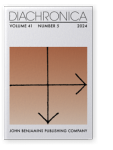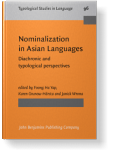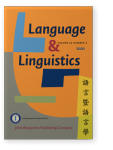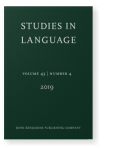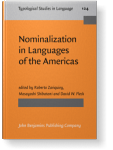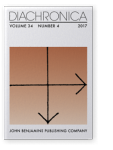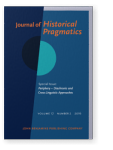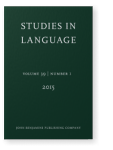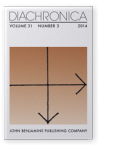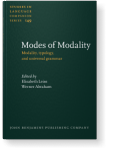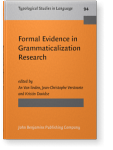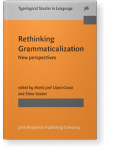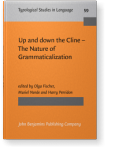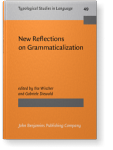Foong Ha Yap
List of John Benjamins publications for which Foong Ha Yap plays a role.
Journal
Title
Nominalization in Asian Languages: Diachronic and typological perspectives
Edited by Foong Ha Yap, Karen Grunow-Hårsta and Janick Wrona
[Typological Studies in Language, 96] 2011. xvii, 796 pp.
Subjects Historical linguistics | Syntax | Theoretical linguistics | Typology
2021 On the relationship between middles and passives: A polyfunctional analysis of - eci in Contemporary Korean Language and Linguistics 22:2, pp. 213–242 | Article
Previous studies using diachronic data from the Sejong Historical Corpus have traced the semantic extension of voice marker -eci from middle to passive uses (e.g. Ahn & Yap 2017). In this study, based on data from the Sejong Contemporary Spoken Corpus, we further examine the relationship between… read more
2019 Assertion, presumption and presupposition: An account of the erstwhile nominalizer YUM in Khalkha Mongolian Studies in Language 43:4, pp. 896–940 | Article
In this paper, we analyze the clitic YUM (< ‘thing’) in Khalkha Mongolian which, in different syntactic contexts, reinforces assertiveness or expresses different shades of presumption or presupposition. The former holds for declaratives where the presence of YUM conveys the speaker’s strong… read more
2019 Chapter 9. Life of =ti: Use and grammaticalization of a clausal nominalizer in Yurakaré Nominalization in Languages of the Americas, Zariquiey, Roberto, Masayoshi Shibatani and David W. Fleck (eds.), pp. 363–390 | Chapter
In this paper, we investigate the uses of the clausal nominalizer =ti in Yurakaré, a linguistic isolate spoken in Bolivia. Clauses nominalized with =ti can serve a variety of functions: filling an argument position, relativization, forming the complement of a complement-taking verb, and expressing… read more
2017 From middle to passive: A diachronic analysis of Korean - eci constructions Diachronica 34:4, pp. 437–469 | Article
This paper examines the relationship between middle and passive voice constructions in Korean, in particular how they have come to share the same grammatical marker -eci. Based on diachronic data from the UNICONC (Korean historical) database, spanning Old, Middle and Modern Korean (15th to 20th… read more
2016 Chinese interrogative particles as talk coordinators at the right periphery: A discourse–pragmatic perspective Periphery – Diachronic and Cross-Linguistic Approaches, Higashiizumi, Yuko, Noriko O. Onodera and Sung-Ock S. Sohn (eds.), pp. 178–207 | Article
This paper examines how utterance-final interrogative particles in Chinese contribute to the management of local and global coherence in conversational discourse. Using Schiffrin’s (1987) model of discourse coherence, and focusing in particular on the Cantonese particle ho2 we show how an… read more
2015 Evidentiality in interaction: A pragmatic analysis of Korean hearsay evidential markers Studies in Language 39:1, pp. 46–84 | Article
This paper examines how hearsay evidential markers in Korean are used within the pragmatic domain to serve a wide range of epistemic and politeness functions. In particular, we focus on a new paradigm of hearsay evidential markers — more specifically, the V-ta ha-X > V-ta-X type, among them -tako,… read more
2014 On the development of Korean SAY evidentials and their extended pragmatic functions Diachronica 31:3, pp. 299–336 | Article
This paper examines the development of five hearsay evidential markers in Korean, namely, tako, tamye, tamyense, tanun and tanta, and traces their extended pragmatic functions in discourse. We first identify their functions over time, from Middle Korean to Modern and Contemporary Korean, then… read more
2014 Epistemic, evidential and attitudinal markers in clause-medial position in Cantonese Modes of Modality: Modality, typology, and universal grammar, Leiss, Elisabeth and Werner Abraham (eds.), pp. 219–260 | Article
This paper examines two types of clause-medial stance markers in Cantonese.* We trace the evolution of these stance markers from their lexical origins as complement-taking psych verbs and directional verbs. Similar to English I think parentheticals, the evolution of the Cantonese psych verbs (e.g.… read more
2011 Referential and non-referential uses of nominalization constructions in Malay Nominalization in Asian Languages: Diachronic and typological perspectives, Yap, Foong Ha, Karen Grunow-Hårsta and Janick Wrona (eds.), pp. 627–658 | Article
This paper examines three versatile morphemes – yang, -nya and punya – that contribute to the formation of nominalization constructions in Malay. In particular, we examine how these morphemes give rise to both referential and non-referential uses of nominalization constructions. We also highlight… read more
2011 From light noun to nominalizer and more: The grammaticalization of zhe and suo in Old and Middle Chinese Nominalization in Asian Languages: Diachronic and typological perspectives, Yap, Foong Ha, Karen Grunow-Hårsta and Janick Wrona (eds.), pp. 61–108 | Article
In this paper, we examine how Chinese light nouns zhe and suo evolved into agent and patient nominalizers respectively. The link between nominalization, relativization and genitivization is explored from a grammaticalization perspective; likewise the frequent relationship between nominalization and… read more
2011 Introduction: Nominalization strategies in Asian languages Nominalization in Asian Languages: Diachronic and typological perspectives, Yap, Foong Ha, Karen Grunow-Hårsta and Janick Wrona (eds.), pp. 1–58 | Article
This paper examines a wide range of nominalization strategies found in Asian languages, and identifies robust grammaticalization pathways that trace the life of versatile nominalizers, particularly those that develop from light nouns and noun phrase markers such as classifiers, plural markers,… read more
2010 Delexicalizing di: How a Chinese noun has evolved into an attitudinal nominalizer Formal Evidence in Grammaticalization Research, Van linden, An, Jean-Christophe Verstraete and Kristin Davidse (eds.), pp. 63–92 | Article
This paper traces the semantic extension of the Chinese locative/spatial noun di (‘bottom’) into a nominalizer, which further develops into a relativizer and genitive marker, and also into an adverbial subordinator and an attitudinal or stance marker. As subordinator and stance marker, di is… read more
2008 The development of nominalizers in East Asian and Tibeto-Burman languages Rethinking Grammaticalization: New perspectives, López-Couso, María José and Elena Seoane (eds.), pp. 309–341 | Article
This paper presents evidence of recurring patterns as well as of language-specific variations in the development of nominalizers across several East Asian and Tibeto-Burman languages. Special attention is pa to the different grammaticalization pathways of nominalizer morphemes and to the links… read more
2004 From pronominalizer to pragmatic marker: Implications for unidirectionality from a crosslinguistic perspective Up and down the Cline – The Nature of Grammaticalization, Fischer, Olga, Muriel Norde and Harry Perridon (eds.), pp. 137–168 | Article
2002 Grammaticalization of ‘give’: African and Asian perspectives New Reflections on Grammaticalization, Wischer, Ilse and Gabriele Diewald (eds.), pp. 217–235 | Article
